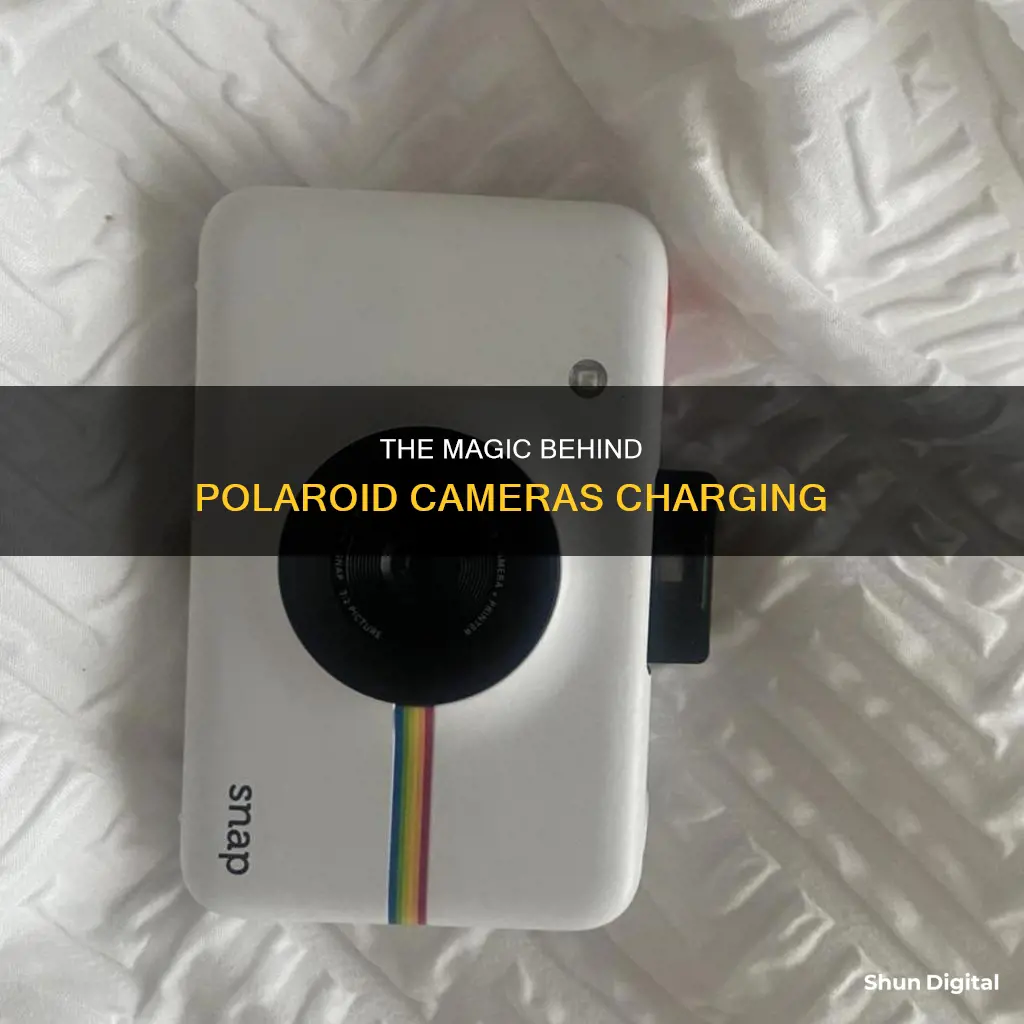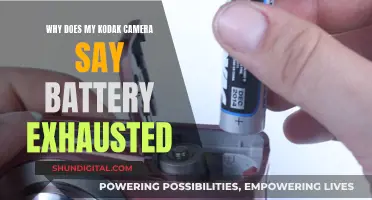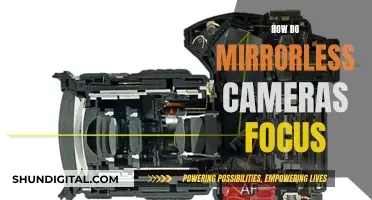
Polaroid cameras, known for their ability to produce photographs seconds after a picture is taken, marked a turning point in the consumer camera industry in the 1970s. The instant photography of Polaroid cameras is made possible by a chemical reaction that occurs under the surface of the negatives. The question of how Polaroid cameras are charged relates to the batteries within the film packs. Older Polaroid cameras like the Polaroid One 600 and film types such as SX-70 and 600 include a flat battery within the film pack. The battery is located within the film pack and is evident by two cutouts in the plastic cover with a metal surface visible.
What You'll Learn

Polaroid OneStep 600 camera batteries are in the film pack
The Polaroid OneStep 600 camera is powered by a battery contained within the film pack. This means that the camera does not have its own power source and will only turn on if the film pack's battery still has power. Each pack of film contains a fresh battery to power the camera. The film pack's battery is usually a Polapulse battery rated at 6-6.3V, a small footprint battery that uses Zink-Chloride chemistry.
To check if the film cartridge's battery still has power, you can pull it out of the camera and wait about 10 seconds before putting it back in and closing the door. If you hear the camera making sounds, then the battery is still good.
If you have a cartridge with good film but a dead battery, you can transfer the film into a cartridge with a good battery in a dark room. This process involves removing the film from the old cartridge and inserting it into the new cartridge in complete darkness. However, it is important to note that replacing the battery inside the film pack is not an option, as these batteries are no longer produced and cannot be recharged.
Some Polaroid 600 users have modified their cameras to take an external battery so that they can use i-type film, which is identical to 600 film but does not include a battery in the cartridge. This modification involves wiring an external battery pack to the camera, with the battery voltage necessary being 6V.
Are Camera Batteries Charged? Understanding Camera Battery Basics
You may want to see also

The battery is changed by replacing the film pack
The Polaroid OneStep 600 is a camera that takes and develops its own pictures. It features an automatic flash as well as a special lens for close-up photos. The battery on these cameras is in the film pack. This means that the battery is changed by replacing the film pack.
The film pack contains a tiny battery that has just enough power to take around ten shots. If you put a film pack into your camera and nothing happens, it is likely that the battery in the pack is dead. This is a common issue with expired genuine Polaroid film that has been sitting on a shelf for several years.
To change the battery, you will need to move the film from the cartridge with a dead battery to a new cartridge with a working battery. First, finish off a working cartridge, and instead of throwing it away, keep it to use again. Then, in a dark room, transfer the film from the old cartridge to the new one. This process can be tricky, and it must be done in complete darkness, so it is a good idea to practice the process in the light with a few previously exposed Polaroids.
To remove the film from the old cartridge, simply slide it out. Inserting the film into the new cartridge is a bit more difficult. You will need to press down the metal base as you insert the film through the slot in the front. The slot is located just above the black plastic material. If you don’t hold down the metal base properly, the film will not completely slide in. Pull it almost completely out and try again until you get it. Repeat this process until all the film is moved.
Be aware that the sheet of film on the top of the stack will be sacrificed as the darkslide when you re-insert the cartridge into the camera, so put either an exposed Polaroid or an actual darkslide on the top. The darkslide is the black piece of cardboard that sits on the stack of undeveloped images to protect them from light.
Charging Your ADT Doorbell Camera: Quick and Easy Steps
You may want to see also

Polaroid cameras use a flat battery within the film pack
Polaroid cameras are loaded with film packs containing sheets of plastic negatives covered in reactive chemicals. When you take a photo, rollers inside the camera remove a negative from the pack and position it in front of the camera lens. The shutter then opens, exposing the film to incoming light, and after the required exposure time, the camera rollers eject the negative, allowing you to remove the picture.
The instant photography of Polaroid cameras is facilitated by a chemical reaction beneath the surface of the silver compounds on the negatives. These chemical layers react in the presence of a reagent, producing the colours captured in the silver layers of the negative. The reagent is released when the rollers eject the photo and press down on the negative. As the reagent covers the silver surface, it triggers the chemical reaction that forms the image.
The Polaroid OneStep 600 Camera, for example, takes and develops its own pictures. It features an automatic flash and a special lens for close-up photos. This camera, and other Polaroid models, use a flat battery within the film pack. This is evident when turning the film pack around and observing two cutouts in the plastic cover with a metal surface visible. A good battery should show over 6 VDC when checking with a digital voltmeter.
It is important to note that newer film types do not include batteries anymore.
Dodge Charger GT: Reverse Camera Availability
You may want to see also

The battery should show over 6 VDC with a digital voltmeter
When checking with a digital voltmeter, a good Polaroid camera battery should show over 6 VDC. This is a measurement of the voltage, or electrical pressure, of the battery. The higher the voltage, the greater the pressure.
To locate the battery, look for two cutouts in the plastic cover of the film pack. If you see a metal surface, this is the battery.
The Polaroid OneStep 600 Camera, for example, takes and develops its own pictures. It features an automatic flash and a special lens for close-up photos. This model uses a type of battery called a Polapulse battery, rated at 6-6.3V. These batteries are no longer produced and cannot be recharged.
If your Polaroid camera is not working properly, it may be due to a low battery. You can check the battery voltage with a digital voltmeter to ensure it is above 6 VDC. If the battery is low, you may need to change the film pack or transfer the film to a new cartridge with a good battery.
Ring's Camera Fees: What's the Real Cost?
You may want to see also

Newer film types don't include batteries
The Polaroid OneStep 600 Camera is a vintage Polaroid camera that does not have a battery. Instead, the film cartridge itself has a tiny battery that powers the camera for about ten shots. This is also the case for traditional Polaroid films like the SX-70 and 600, which include a flat battery within the film pack. However, newer film types do not include batteries anymore.
The absence of batteries in newer film types for Polaroid cameras is a significant shift from traditional Polaroid films. Previously, the film pack served as the power source, providing just enough energy for a limited number of photographs. This design choice had its advantages and disadvantages. On the one hand, having a battery in the film pack ensured that the camera would have the power it needed to operate. But, on the other hand, it also meant that the camera was dependent on the film pack's battery for functionality.
With newer film types, the power source has shifted elsewhere. For instance, the Polaroid Originals' I-Type film, which is similar to the Polaroid 600 film, does not include a battery. Instead, the I-Type cameras, such as the One Step 2 and OneStep+, have their own lithium battery. This built-in battery powers the camera's functions, including the flash, autofocus, and timers. By separating the power source from the film pack, Polaroid has addressed the issue of expired or dead batteries in older film packs, ensuring that users don't have to worry about the battery life of their film cartridges.
It is worth noting that not all Polaroid camera models rely on electrical power. Some models, like the 180/195, Holgaroids, and simple packfilm backs for other camera systems, are manual cameras that require no power to expose or develop images. These purely mechanical cameras offer a different experience, free from concerns about battery life or power sources.
Kodak Camera Charging: How to Know It's Charging?
You may want to see also
Frequently asked questions
Polaroid cameras don't need to be charged. They are loaded with film packs containing sheets of plastic negatives covered in reactive chemicals. When you take a picture, rollers inside the camera expose the film to incoming light from the lens.
The battery on the Polaroid One 600 is in the film pack. To change the battery, you need to change the film pack.
No, there is no realistic way to change the battery inside a film pack. If you have a cartridge with good film but a dead battery, you can transfer the film into a cartridge with a good battery in a dark room.
No, newer film types do not include batteries.







